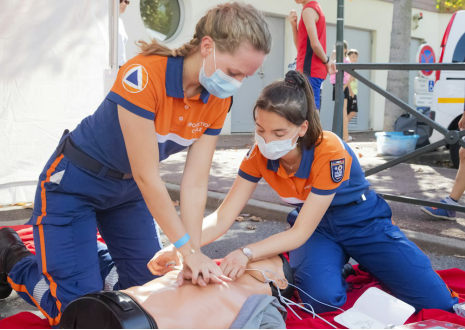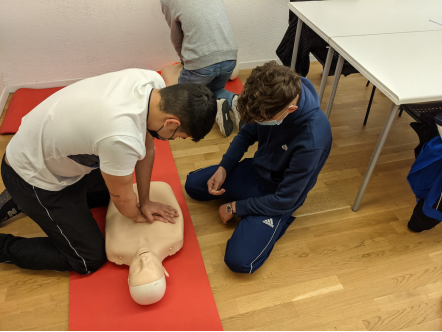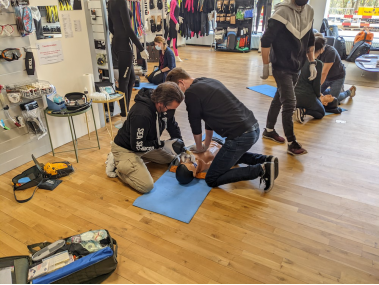
In the dynamic world of healthcare, every second counts. For nurses, doctors, and EMTs, being equipped with the knowledge of Basic Life Support (BLS) is not just a requirement but a profound responsibility.
In this article, we’ll unravel the intricacies of BLS for healthcare providers with a guide that goes beyond the basics to empower those at the frontline of saving lives.
Here’s what you need to know:
The Foundation of BLS
Understanding BLS Essentials:
BLS for healthcare providers is the bedrock of emergency response in clinical settings. It's more than just chest compressions and rescue breaths; it's a sequence of actions orchestrated with precision to optimize the chances of survival.
- Immediate Recognition of Cardiac Arrest
- In the fast-paced healthcare environment, recognizing cardiac arrest is the first crucial step. It's not always as dramatic as portrayed in medical dramas; sometimes, it's a subtle shift in a patient's condition.
- Quick assessment is the key – check responsiveness and breathing. If absent or irregular, you're dealing with a potential cardiac emergency.
- Activating Emergency Response
- Time is a precious commodity in healthcare, and wasted time can be a matter of life and death. Once cardiac arrest is identified, activating the emergency response system is paramount.
- Ensure someone calls for help while you initiate the initial steps of BLS.
- High-Quality CPR
- CPR is the linchpin of BLS, and for healthcare providers, the emphasis is on high-quality compressions. It's not just about pumping the chest; it's about doing it effectively.
- Aim for a depth of at least 2 inches, allow for full chest recoil, and maintain a rate of 100-120 compressions per minute. It's the rhythm of life.

Tailoring BLS for Healthcare Professionals:
Nurses, Doctors, and EMTs: A Unified Approach:
- BLS for Nurses
- Nurses are often the first responders in healthcare settings. Their role in BLS extends beyond clinical settings to everyday life. Whether in a hospital or a community setting, nurses are the unsung heroes of immediate care.
- BLS training for nurses involves honing skills to transition from routine care to life-saving interventions. It's a delicate balance that requires agility and expertise.
- BLS for Doctors
- For doctors, the BLS mantra is about leading by example. In critical situations, doctors must seamlessly integrate BLS into their clinical acumen. The ability to command a room, make swift decisions, and initiate BLS with precision is a hallmark of medical leadership.
- Beyond the technicalities, BLS for doctors is about maintaining composure in the face of chaos and instilling confidence in the healthcare team.
- BLS for EMTs
- EMTs are the lifeline between the scene of an emergency and the healthcare facility. BLS for EMTs involves a unique set of challenges – working in diverse environments, often with limited resources.
- Mobility and adaptability are key in BLS training. EMTs must be adept at providing BLS in the back of an ambulance, on a street corner, or in a crowded public space. Their training is a testament to the unpredictable nature of emergency response.

Special Considerations in BLS for Healthcare Providers:
Beyond the Basics:
- Advanced Airway Management
- Healthcare providers often deal with patients whose airways become compromised due to various medical conditions. BLS extends to advanced airway management, including techniques such as endotracheal intubation.
- Knowing when and how to secure a patient's airway is a skill that can be the difference between successful resuscitation and complications.
- Use of Automated External Defibrillators (AEDs)
- AEDs are a common sight in healthcare settings, and healthcare providers must be proficient in their use. BLS involves not just CPR but also knowing when and how to deploy an AED effectively.
- The automated nature of AEDs doesn't diminish the importance of provider expertise; rather, it underscores the need for a seamless integration of technology into the BLS algorithm.
- Team Dynamics in BLS
- In healthcare, it's rare for a single provider to handle a cardiac arrest alone. BLS training extends to understanding and optimizing team dynamics.
- Effective communication, task delegation, and maintaining a shared mental model are critical components of BLS for healthcare providers. It's a symphony of skills that ensures every healthcare team member plays their part in the life-saving orchestra.

No comments yet